
Charismatic species
The red-crowned crane is one of many species of animals and plants that
inhabit Hokkaido. Here are some of the species.
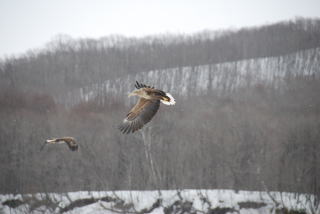
white-tailed sea eagle
(Haliaeetus albicilla)
About 150 pairs breed in forests near water in eastern and northern Hokkaido. In addition to the residents, more than 500 individuals winter in Hokkaido.
(Haliaeetus albicilla)
About 150 pairs breed in forests near water in eastern and northern Hokkaido. In addition to the residents, more than 500 individuals winter in Hokkaido.
 arctic iris
arctic iris
(Iris setosa)
The wild iris found commonly in wetlands and margins of pastures in Hokkaido. This is the same species of wild iris found in arctic, subarctic, and cool temperate regions of North America, Siberia, China, and the Korean Peninsula. It flowers in June and July.

Sakhalin taimen
(Parahucho perryi)
The largest freshwater fish in Japan. It grows to more than 1 m long. Due to loss of habitats, the population size of this species has been decreasing.
(Parahucho perryi)
The largest freshwater fish in Japan. It grows to more than 1 m long. Due to loss of habitats, the population size of this species has been decreasing.
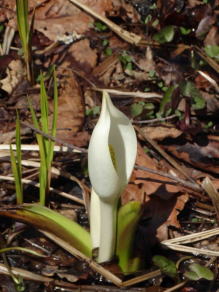 Asian skunk cabbage
Asian skunk cabbage(Lysichiton camtschatcensis)
One of the first plants to flower in wetlands in spring. It is related to the western skunk cabbage in the western USA, which is known for its unpleasant smell. However, the Asian skunk cabbage does not have an unpleasant smell.
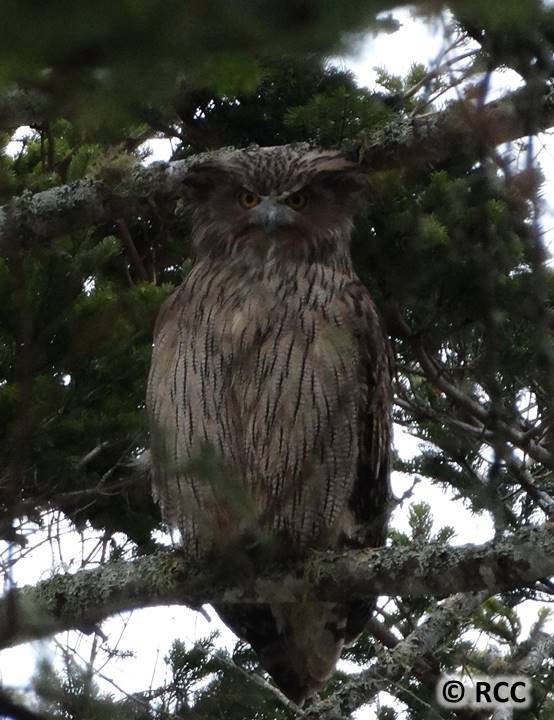
Blakiston‘s fish-owl
(Ketupa blakistoni)
IUCN lists this species as endangered. This species breeds mostly in south-eastern Russia and Hokkaido. It nests in hollows on large trees and hunts fish, frogs, and small mammals along rivers, streams and coasts. Indigenous people of Hokkaido (the Ainu) call this species the god that protects villages.
(Ketupa blakistoni)
IUCN lists this species as endangered. This species breeds mostly in south-eastern Russia and Hokkaido. It nests in hollows on large trees and hunts fish, frogs, and small mammals along rivers, streams and coasts. Indigenous people of Hokkaido (the Ainu) call this species the god that protects villages.
 Siberian salamander
Siberian salamander(Salamandrella keyserlingii)
This is a relict species that has colonized the Kushiro wetland from continental Asia more than 10000 years ago. This species can survive deep freezing of its body during winter.

brown bear
(Ursus arctos)
It is the largest terrestrial mammal in Hokkaido. Brown bears are not endangered, but sightings are not common in most parts of Hokkaido. The indigenous people (the Ainu) call this species the god of mountains.
(Ursus arctos)
It is the largest terrestrial mammal in Hokkaido. Brown bears are not endangered, but sightings are not common in most parts of Hokkaido. The indigenous people (the Ainu) call this species the god of mountains.
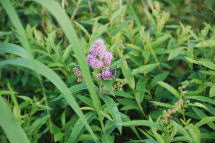 willowleaf meadowsweet
willowleaf meadowsweet(Spiraea salicifolia)
Commonly found in wetlands in eastern Hokkaido. This species is also distributed across northern Eurasia. It forms impenetrable thickets in drier parts of wetlands. This species flowers in mid- to late summer.

Filipendula glaberrima
Related to the meadowsweet and dropwort in Europe and queen-of-the-forest and queen-of-the-prairie in North America. This species tends to grow in the margins of swamp woodlands. The flowerhead is made of many tiny intricate flowers and is stunningly beautiful.
Related to the meadowsweet and dropwort in Europe and queen-of-the-forest and queen-of-the-prairie in North America. This species tends to grow in the margins of swamp woodlands. The flowerhead is made of many tiny intricate flowers and is stunningly beautiful.
 Steller‘s sea eagle
Steller‘s sea eagle(Haliaeetus pelagicus)
IUCN lists this species as vulnerable. It breeds in Russian far east, and more than 1000 individuals winter in Hokkaido each year.

sika deer
(Cervus nippon)
In recent years, the population size of sika deer in Hokkaido has exploded, and it is not uncommon to see sika deer in wetlands or forests, especially in winter.
(Cervus nippon)
In recent years, the population size of sika deer in Hokkaido has exploded, and it is not uncommon to see sika deer in wetlands or forests, especially in winter.
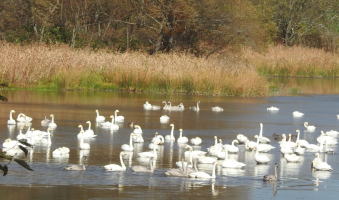 whooper swan
whooper swan(Cygnus cygnus)
This species can be seen in the same habitats as the cranes from November to early May. In fall and spring, one may see a flock of more than 1000 swans.

diving bell spider
(Argyroneta aquatica)
This is another example of a relict species that colonized the Kushiro wetland more than 10000 years ago. It is one of a few species of spiders that completes its entire life cycle under water.
(Argyroneta aquatica)
This is another example of a relict species that colonized the Kushiro wetland more than 10000 years ago. It is one of a few species of spiders that completes its entire life cycle under water.
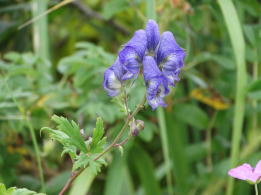 monkshood
monkshood(Aconitum sachalinense)
This species occurs in Hokkaido and south-eastern Russia. Of over 250 species of monkshood, this species is said to have the strongest toxin. The indigenous people (the Ainu) used the toxin extracted from roots of this plant when hunting brown bears. It flowers in late summer.
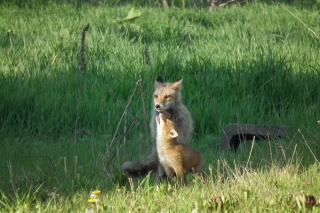
red fox
(Vulpes vulpes)
The red fox is the most visible of mammalian predators. It is not uncommon to spot a fox or two while driving in the countryside. This species is one of main predators of red-crowned cranes in Hokkaido.
(Vulpes vulpes)
The red fox is the most visible of mammalian predators. It is not uncommon to spot a fox or two while driving in the countryside. This species is one of main predators of red-crowned cranes in Hokkaido.
 Japanese iris
Japanese irisThe wild stock of the iris commonly cultivated throughout Japan. It is abundant in some wetlands in eastern Hokkaido. This species flowers from late June to early August.
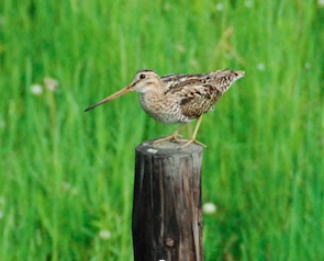
Latham‘s snipe
(Gallinago hardwickii)
This pigeon-sized snipe breeds in the Russian far east and northern Japan and winters in eastern Australia. At least some individuals fly non-stop between their breeding and wintering grounds.
(Gallinago hardwickii)
This pigeon-sized snipe breeds in the Russian far east and northern Japan and winters in eastern Australia. At least some individuals fly non-stop between their breeding and wintering grounds.
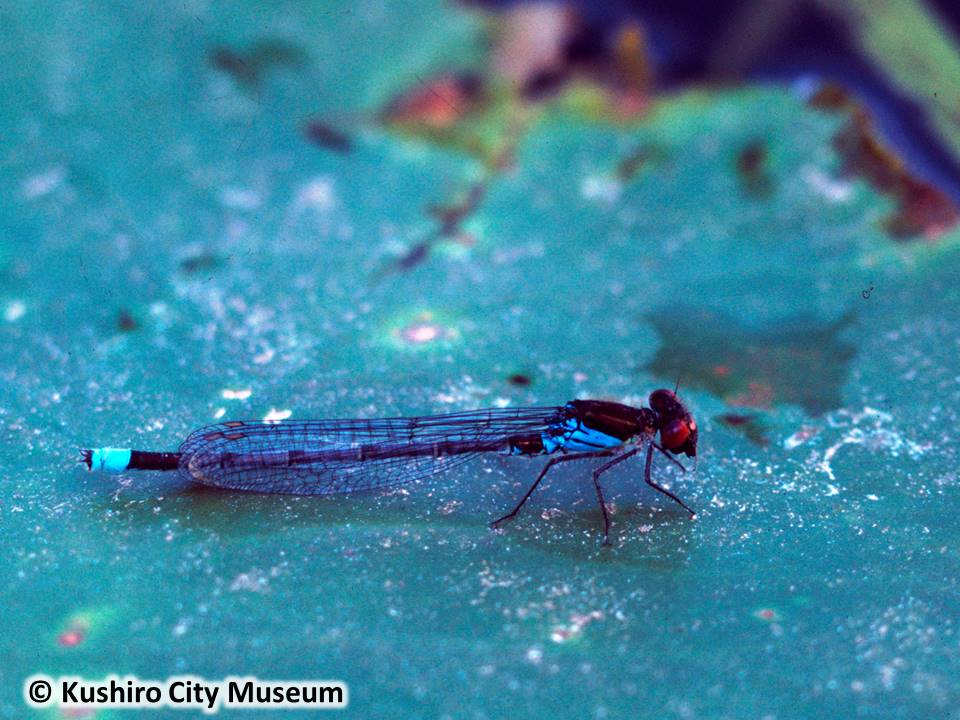 red-eyed damselfly
red-eyed damselfly(Erythromma najas)
The best time to see this attractive damselfly is from late June to mid-August. This species occurs in eastern Hokkaido and Siberia.
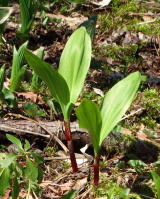
Siberian onion
(Allium victorialis)
New growth in early spring is highly sought after as a wild vegetable in Japan. Each local resident has his or her own secret patch, and its location is not revealed even to family members.
(Allium victorialis)
New growth in early spring is highly sought after as a wild vegetable in Japan. Each local resident has his or her own secret patch, and its location is not revealed even to family members.
 Jacob‘s-ladder
Jacob‘s-ladder(Polemonium caeruleum)
This subspecies of Jacob‘s-ladder is found only in eastern Hokkaido. It flowers briefly in early summer, and the chance to see these delicate blue flowers is easily missed.

cotton grass
(Eriophorum vaginatum)
In Hokkaido, the cotton grass is found only in boggy wetlands. Mass flowering occurs once every several years.
(Eriophorum vaginatum)
In Hokkaido, the cotton grass is found only in boggy wetlands. Mass flowering occurs once every several years.
 Ezo salamander
Ezo salamander(Hynobius retardatus)
Endemic to Hokkaido, this species feeds on invertebrates and small vertebrates, including other individuals of the same species. Unlike the Siberian salamander, this species needs to hibernate in deep water or soil to avoid freezing of its body.

Siberian rubythroat
(Calliope calliope)
This sparrow-sized songbird breeds in Hokkaido and eastern Russia and winters in Southeast Asia. It is found in open habitats with some thickets.
(Calliope calliope)
This sparrow-sized songbird breeds in Hokkaido and eastern Russia and winters in Southeast Asia. It is found in open habitats with some thickets.
 peacock butterfly
peacock butterfly(Aglais io)
They are common in areas where wooded hills meet pastures. Undersides of the wings are almost black. They look like a different species when the wings are shut.

Spectacled guillemot
(Cepphus carbo)
This pigeon-sized seabird breeds in northern Japan and eastern Russia. The population size in Japan has decreased dramatically in recent decades.
(Cepphus carbo)
This pigeon-sized seabird breeds in northern Japan and eastern Russia. The population size in Japan has decreased dramatically in recent decades.
 water caltrop
water caltrop(Trapa japonica)
It is ubuquitus in shallow and still water bodies. Seeds have four hard spikes but are eaten by the bean goose. People in Eurasia have also used the seed for food and medicine.

whiteface
(Leucorrhinia intermedia)
This beautiful dragonfly belongs to a group known as whitefaces. This particular species occurs in Siberia and in the vicinity of the Kushiro wetland.
(Leucorrhinia intermedia)
This beautiful dragonfly belongs to a group known as whitefaces. This particular species occurs in Siberia and in the vicinity of the Kushiro wetland.
 tussock sedge
tussock sedge(Carex caespitosa)
Tussocks are often found in the understory of semi-open wooded wetlands but are sometimes seen in open wetlands.
Reference:
- Ministry of the Environment (Japan), ed. 2014. Red Data Book 2014 -Threatened Wildlife of Japan- Volume 2, Aves (in Japanese with English summary). GYOSEI Corporation, Tokyo.
タンチョウ保護研究グループタンチョウ保護研究グループ
〒085-0036
北海道釧路市若竹町9-21
TEL 0154-22-1993
FAX 0154-22-1993
Red-crowned Crane Conservancy
9-21 Wakatake-Cho,
Kushiro, Hokkaido 085-0036
JAPAN
TEL +81-154-22-1993
FAX +81-154-22-1993
あなたは
番目の訪問者です。